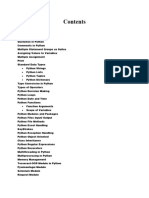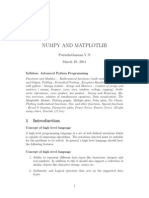0 ratings0% found this document useful (0 votes)
6 views2-Basic of Python
Python uses indentation rather than braces to indicate blocks of code. Statements typically end with a new line, but the line continuation character allows continuing a line. Blank lines and lines with only whitespace or comments are ignored. Semicolons allow multiple statements per line if no new block is started. Standard data types include numbers, strings, lists, tuples, and dictionaries. Numbers can be integers, floats, or complexes. Strings use quotes, lists use brackets, tuples are like read-only lists, and dictionaries are hash tables. Data type conversion functions allow changing between types.
Uploaded by
rajinderCopyright
© © All Rights Reserved
Available Formats
Download as PDF, TXT or read online on Scribd
0 ratings0% found this document useful (0 votes)
6 views2-Basic of Python
Python uses indentation rather than braces to indicate blocks of code. Statements typically end with a new line, but the line continuation character allows continuing a line. Blank lines and lines with only whitespace or comments are ignored. Semicolons allow multiple statements per line if no new block is started. Standard data types include numbers, strings, lists, tuples, and dictionaries. Numbers can be integers, floats, or complexes. Strings use quotes, lists use brackets, tuples are like read-only lists, and dictionaries are hash tables. Data type conversion functions allow changing between types.
Uploaded by
rajinderCopyright
© © All Rights Reserved
Available Formats
Download as PDF, TXT or read online on Scribd
You are on page 1/ 14
Basic of Python
Lines & Indentation
• Python does not use braces({}) to indicate
blocks of code for class and function
definitions or flow control. Blocks of code are
denoted by line indentation, which is rigidly
enforced.
Multi-Line Statements
• Statements in Python typically end with a new
line. Python, however, allows the use of the
line continuation character (\) to denote that
the line should continue
Quotation in Python
• Python accepts single ('), double (") and triple
(''' or """) quotes to denote string literals, as
long as the same type of quote starts and
ends the string
Using Blank Lines
• A line containing only whitespace, possibly
with a comment, is known as a blank line and
Python totally ignores it.
Multiple Statements on a Single Line
• The semicolon ( ; ) allows multiple statements
on a single line given that no statement starts
a new code block.
Multiple Statement Groups as Suites
• Groups of individual statements, which make
a single code block are called suites in Python.
Standard Data Types
Python has five standard data types-
• Numbers
• String
• List
• Tuple
• Dictionary
Python Numbers
• Number data types store numeric values.
Number objects are created when you assign
a value to them.
• Python supports three different numerical
types −
• int (signed integers)
• float (floating point real values)
• complex (complex numbers)
Python Strings
• Strings in Python are identified as a
contiguous set of characters represented in
the quotation marks.
Python Lists
• Lists are the most versatile of Python's
compound data types. A list contains items
separated by commas and enclosed within
square brackets ([]).
Python Tuples
• A tuple is another sequence data type that is
similar to the list. Tuples can be thought of as
read-only lists.
Python Dictionary
• Python's dictionaries are kind of hash-table
type.
Data Type Conversion
• Sometimes, you may need to perform
conversions between the built-in types. To
convert between types, you simply use the type-
name as a function.
>>x=“1”
>>> type(x) <class 'str'>
>>> y=int(x)
>>> type(y) <class 'int'>
You might also like
- ITEC 111 Python 02 - Intro To Python Part 2No ratings yetITEC 111 Python 02 - Intro To Python Part 238 pages
- Problem Solving Using Python (ITFC0101) : Variables and Data TypeNo ratings yetProblem Solving Using Python (ITFC0101) : Variables and Data Type56 pages
- Workshop On Python For Beginners: Hearty Welcomes ToNo ratings yetWorkshop On Python For Beginners: Hearty Welcomes To35 pages
- Class IX Robotics(Introduction to Data - Programming with Python) Lesson 2 Introduction to Data Types and Variables Session 2024--25No ratings yetClass IX Robotics(Introduction to Data - Programming with Python) Lesson 2 Introduction to Data Types and Variables Session 2024--259 pages
- AI CHAPTER 5 PYTHON NOTES - Class IX (2)No ratings yetAI CHAPTER 5 PYTHON NOTES - Class IX (2)50 pages
- Numpy and Matplotlib: Purushothaman.V.N March 10, 2011No ratings yetNumpy and Matplotlib: Purushothaman.V.N March 10, 201127 pages
- Full Python Tutorial - Dipartimento Di InformaticaNo ratings yetFull Python Tutorial - Dipartimento Di Informatica116 pages
- Problem Solving Using Python (ITFC0101) : Variables and Data TypeProblem Solving Using Python (ITFC0101) : Variables and Data Type
- Workshop On Python For Beginners: Hearty Welcomes ToWorkshop On Python For Beginners: Hearty Welcomes To
- Class IX Robotics(Introduction to Data - Programming with Python) Lesson 2 Introduction to Data Types and Variables Session 2024--25Class IX Robotics(Introduction to Data - Programming with Python) Lesson 2 Introduction to Data Types and Variables Session 2024--25
- Numpy and Matplotlib: Purushothaman.V.N March 10, 2011Numpy and Matplotlib: Purushothaman.V.N March 10, 2011
- Full Python Tutorial - Dipartimento Di InformaticaFull Python Tutorial - Dipartimento Di Informatica



























































